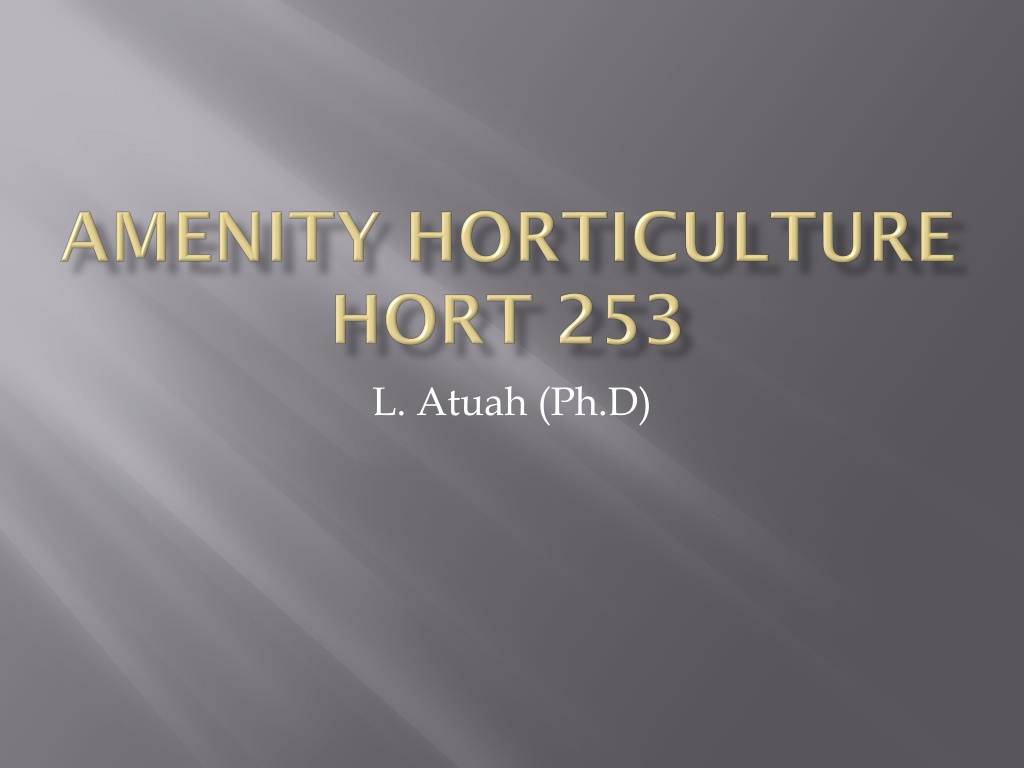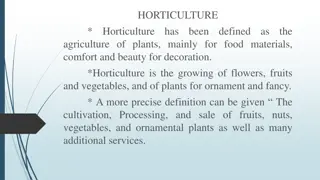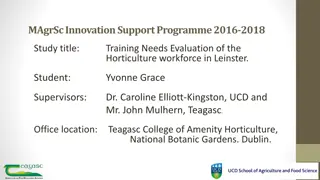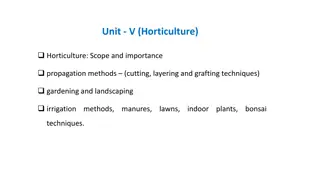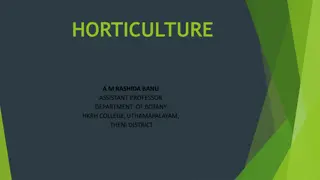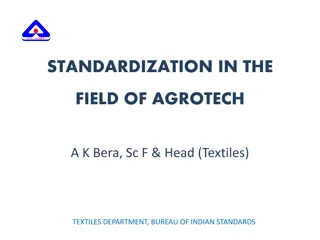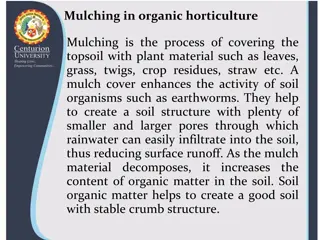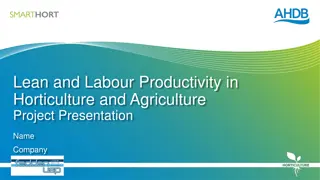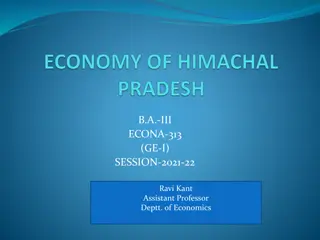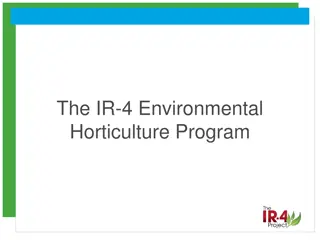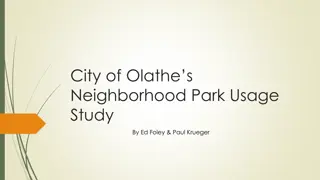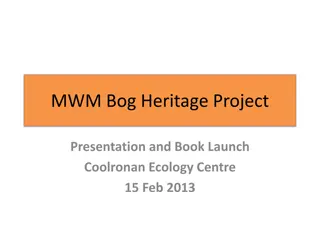Understanding Amenity Horticulture: Challenges, Applications, and Solutions
Explore the world of amenity horticulture, its significance in landscape design, challenges faced, and innovative solutions. Learn about the diversity of plants used for functional and aesthetic purposes in creating attractive environments. Discover the need for multi-professional collaboration, general challenges like vandalism and timeliness, and specific issues in Ghana. Explore potential improvements through education, legislation, research, and creative initiatives. Categorize plants commonly found in landscapes to enhance your understanding of this field.
- Amenity Horticulture
- Landscape Design
- Plant Diversity
- Multi-professional Collaboration
- Ghana Challenges
Download Presentation

Please find below an Image/Link to download the presentation.
The content on the website is provided AS IS for your information and personal use only. It may not be sold, licensed, or shared on other websites without obtaining consent from the author. Download presentation by click this link. If you encounter any issues during the download, it is possible that the publisher has removed the file from their server.
E N D
Presentation Transcript
Amenity horticulture- what it is and its relevance Challenges in amenity horticulture and the way forward Plants in the landscape Plant use functional and aesthetic Maintaining amenity plants Some plant disorders and their treatments
It can be referred to as landscape horticulture or environmental horticulture. The term landscape commonly refers to the appearance of the land, including its shapes, texture and colours. It also reflects the way in which their various components combine to create specific patterns and pictures that are distinctive to particular localities.
The landscape or the natural environment has gone through various modifications which are man made. Amenity horticulture therefore refers to the use of plants in the landscape to effect aesthetic patterns, enhancing comfort and pleasantness. The plants may also serve other functional purposes like checking erosion, screening etc.
Amenity horticulture is therefore applied in such a way that it reflects the set of priorities of the users of a particular environ. Multi-professional collaboration is required to produce the cohesion needed in our landscapes/environs. Name professionals that will be needed for such collaboration and briefly explain why?
General challenges: Vandalism, litter, poisonous plants, hideouts for bad people , timeliness in keeping maintenance schedule. Challenges peculiar to Ghana name as many as you can think of.
Education Legislation More research on ornamental plants and the environment (implying provision of funds) Re-organising the department of Parks and Gardens Innovative ideas like an award for Ghana s most beautiful suburb etc.
The plants in the landscape can be categorised. They may be either of the following; Trees Shrubs Herbaceous perennials Grasses and creeping plants/ground covers Climbers Bromeliads Ferns Cacti and succulents Water plants
Plantings in the landscape may either be formal or informal. Trees: The four main groupings of trees are namely, foliage trees, flowering trees, conifers and palms. Some examples are enlisted in later slides.
Scientific name Common name Some characteristics Ficus benjamina Azadirachta indica Pithecellobium saman Michelia champaca Weeping fig Neem Rain Tree Champac Weeping spreading tree Upright spreading tree Spreading tree Medium size erect and Pyramidal tree Erect fan shaped plant Ravenala madagascariensis Traveller s Tree
Scientific name Common name Some characteristics Cassia fistula Cassia nodosa Lagerstroemia speciosa Poinciana regia Plumeria alba Golden shower Pink shower tree Queen flower Flamboyante Frangipani, Forget-me-not Pendulous yellow flowers Pink flowers Showy purple flowers Large scarlet flowers White flowers
Scientific name Common name Some characteristics Araucaria heterophylla Araucaria bidwilli Cupressus Sp Thuja orientalis Casuarina equisetifolia Norfolk Island Pine Bunyan bunyan Cupressus Thuja Whistling pine Pyramidal evergreen Spiny evergreen Bushy and dense Dense busy pyramidal tree Needle-like leaves
Scientific name Common name Some characteristics Roystonea regia Royal palm There are both tall and dwarf varieties Tall and dwarf varieties Erect tree with spiral leaves Cocos nucifera Caryota urens Coconut palm Toddy Palm Washingtonia filifera
A shrub may be distinguished from a tree by the fact that it is bushy and mostly multi- stemmed (i.e. woody, a plant smaller than a tree and with several woody stems). Shrubs are usually divided into two groups - flowering and foliage. They are grown in the landscape individually as specimen plants or in groups for shelter belt, hedges, bedding plants or in shrubberies.
Flowering shrub: Scientific name Common name Some characteristics Acalypha hispida Allamanda cathartica Monkey tail/red fingers Allamanda Slender long flowers Yellow trumpet shape flowers Has thorns and is a climber Different kinds exists; red, yellow, pink flowers Large heads of crimson flowers Bougainvillea glabra Purple bougainvillea Hibiscus rosa-sinensis Hibiscus/Rose of China Ixora duffi Double red ixora
Scientific name Common name Some characteristics Acalypha willinckii Acalypha wilkesiana Variegated acalypha Acalypha tricolor Has heart-shaped leaves Brown leaves blotched with red Terminal leaves are variegated white Has purple leaves Breynia nivosa Ice plant/snow plant Pseuderanthemum atropurpureum Polyscias spp. Purple eranthemum Panax Several kinds exist
These are perennial herbaceous plants which are either grown for their flowers or foliage. They include bulbous, tuberous and rhizomatous plants. Anthurium andreanum Anthurium lily Scientific name Common name Some characteristics Bears large waxy scarlet flower Numerous varieties with different colours When well irrigated it continue to flower throughout the year Bears yellow bracts Cannot withstand drought Canna spp Canna lily Gerbera jamesonii Barberton daisy Heliconia bihai Pentas parviflora Lobster claw Red Pentas/flaming Katie
Climbing plants consist of both perennial woody, herbaceous plants and annuals. These plants have various devices for climbing which include tendrils, twining stem, root-like holdfasts and drooping or rumbling over a support. Since most climbing plants grow vigorously and consequently carry a lot of vegetation, stakes or supports used must be sufficiently strong.
Scientific name Common name Some characteristics Monstera deliciosa Scindapsus aureus Thunbergia alata Ceriman Scindapsus Black-eyed Susan Has perforated leaves Quick growing Yellow funnel shaped flowers Very useful for covering bare walls Has brittle papery leaves Ficus pumila Creeping fig Petrea volubilis Purple wreath
Turf grasses perform the function of ground cover plants. They are grown mainly in lawns, playing fields etc. Ground cover plants are very useful on slopes, irregular surfaces and in rocky areas where mowing of grass is not possible. Chrysopogon aciculatus Love grass/Tafo grass Scientific name Common name Some characteristics Grows in full sun and semi- shade full sun and semi-shade Does not thrive under shade Violet flowers open in the morning closes by afternoon Very showy yellow flowers Axonopus compressus Cynodon dactylon Setcreasea purpurea Carpet grass Bermuda grass Purple heart Tribulus cistoides Tribulus
Ferns belong to a group of plants which produce pores instead of flowers and seeds. The spores are found on the fronds, usually beneath. Suitable conditions for growth and development; damp semi-shaded conditions with protection from wind. Asparagus plumosus Asparagus fern Scientific name Common name Some characteristics Adiantum capillus-veneris Nephrolepis exaltata Maidenhair fern Sword fern Cannot recover once wilted Fronds are erect and stiff Fern-like with need-like branchlets Can grow both in full sun and semi-shade Asparagus sprengeri Asparagus fern
These plants can withstand a considerable amount of neglect. This is possible because of their resistance to drought, dry, hot and difficult conditions. Cacti has adaptive features to cut down on loss of water through transpiration. These are thickened stems and spines which are modified leaves. The fleshy nature of succulents allow for maximum retention of moisture. Transpiration is further reduced by a thin wax coating or woolly hairs plant parts.
Scientific name Common name Some characteristics Agave americana Century plant Spreading plant with a large rosette of thick and stiff leaves. Sparsely foliaged with spiny stem. Erect house plant bears clusters of scarlet flowers. Euphorbia splendens Christ s Thorn Kalanchoe blossfeldiana Flaming Katy Succulent leaves which are glossy purple beneath and green above. Erect cylindrical pointed leaves. Rhoeo discolor Lady-in-boat/Moses in the cradle Sansevieria trifasciata laurentii Mother-in-law tongue
Three general groups of water plants; Those which grow entirely beneath water, those which have their roots and stem beneath water surface, those with their roots growing in water and stems and leave above water surface. Scientific name Common name Some characteristics Nymphaea spp Water lilies Waxy leaf surface with closely set minute hairs Floating plant preferring shallow waters Floating and bears small dull violet flowers Pistia stratiotes Water lettuce Thalia dealbata Water Canna
Avenue plants Trees with clear trunks (allowing for people to walk under) is ideal. The trees must have aggressive root systems, should not have brittle branches and not be messy (by way of leaf and seed drop). The roots must have deep root system to afford good anchorage. Specimen plants Plants with unique characteristics. They should be sufficiently attractive to stand alone. Hedge Plants (especially shrubs) grown with close spacing and trained in such a way to make a barrier or mark a boundary.
House plants they are plants which can be expected to live permanently under room conditions.
Trees Avenue plantings Provision of shade Specimen Noise control Pollution control Wind breaks
Shrubs: Hedge Median planting to reduce headlamp glares Potted plant Bedding plant Border plant
Beds Borders Establishing an avenue: In avenue planting there should be a layout and design and the following should be considered: Length If an avenue leads from one definite point to another, its length is automatically defined. In other cases, the length should be decided in the light of certain guiding factors including the following:
If too long, an avenue tends to become monotonous. If very long, care must be taken to ensure that it is not too narrow, in which case it will tend to shrink to vanishing point before the end of it is seen. If a very long avenue is made too wide, in order to avoid the last pitfall (shrinkage), the trees of which it is composed will appear to be dwarfed. Avenues should not normally be more than one-half to three-quarters of a mile in length if the above points are to be avoided.
It is difficult to lay down the exact width of an avenue. The habit of the species planted: large crown trees need more space than those with narrow crown. The table below can be used as a guide Length of avenue (m) Width of avenue (m) 91 91-182 182-365 365-548 548-640 640-751 24 9 12 15 18 21 The length of the avenue: long avenues should be rather wider than those of shorter length.
The number of rows of trees of which the avenue is composed: an avenue of two single rows should be rather narrower than one with two double rows. City conditions are often unfavourable for tree growth and species must be selected which can tolerate air pollution, dry conditions, glare from pavements etc. Suitable trees should be planted far enough from the kerb to allow them to spread without too much pruning. They should be kept clear of overhead wires and underground services.
Discuss how a tree can be planted (Steps involved) Trees in car parks The task of accommodating trees within a car park is not always straightforward as it may seem. The challenge on site a car park; are usually hard surface, dry conditions, lack of air and the intensity of the light which is thrown up from the ground to the tree. This can result in leaf scorch and abnormal transpiration rate. Vehicles may damage trees by reversing into them and tree roots can be poisoned if fuel run-off gets into the water supply.
To avoid the afore mentioned hazards it is usually suggested trees in car parks be planted between raised kerbs or in elevated boxes. Hazard fencing at bumper height can go some way to meeting practicalities but the careful siting of trees in relation to the overall car park design gives the best solution. In tree selection, the tree should be able to withstand pollution.
Essentials required are a shovel, rope/string, tape measure, stakes/pegs, compost, spray paint (optional). If a really dense and bushy hedge from ground upwards, it is advisable to plant young small plants. The result of using large plants can often be that the hedge is rather gappy at the base. Soil preparation: Prepare the ground by digging over a strip 60-90cm wide and one spade blade deep. Remove all weeds if a weedkiller has not been used before hand.
Add organic matter such as garden compost, spread it over the soil and mix in top 25 cm of soil with a fork. You may also mix in a general purpose fertilizer. Planting Planting distances vary from 30-60 cm, depending on the plants final size, the size of hedge required and plant vigour. For hedges thicker than 90 plant a staggered double row 45 cm apart with plants 90 cm apart. Trim back damaged roots to healthy growth with a sharp knife.
Spread out the roots, ensuring the planting depth is correct (note that the previous soil mark on the stem indicates how deeply the plants were grown in the nursery). Work soil between the roots, firm plants in so that soil is in close contact with the roots. Then water. Mulch to a depth of 7.5cm after planting to prevent weeds. Why will one plant a hedge? What kind of plants are recommended for median planting?
These are plants which are grown in beds and borders to give color to a landscape environment. They include annuals, biennials, herbaceous perennials, ferns, fern-like plants, orchids, cacti and succulents and shrubs. Beds stand as an island of selected flowering plants. They could take any shape especially geometric shapes; square, oval etc. If the bed is sited in a lawn you will have to be careful your chosen shape will not hamper mowing of the grass. If you plan a large bed you will have to make provision for access in order to facilitate maintenance.
Beds should be viewable from different angles. Borders- They are planted against a wall or hedge. The plants in a border will therefore be affected by shadow from the wall, possible reduced impact of rain. Take into consideration the backdrop when planning the colour scheme of the border. Be aware also of the fact that maintenance works on the wall or hedge can affect the plantings in the border. How can you establish a bed; square and circular shape?
Lawn: A smooth layer of land covered with turf. Turf: A ground cover of grass which is kept mown and which will stand a reasonable amount of traffic. Verge: A narrow strip of turf between beds, paths, walls etc. Preparations involved: Soil preparation is essential to ensure there is quick establishment of uniform turf. The goal is to create a fertile homogeneous root zone with acceptable infiltration, aeration and drainage.
Depending upon the scope of the project advance planning may be of relatively little or of very great importance. In general turf can be established from seeds or vegetatively. This could be by sodding, plugging, stolonizing and sprigging. Sodding: The process of installing mature turf in large or small sheets, as opposed to spreading seed or sprigs over a prepared area of bare soil. Sod is established turf that is harvested with roots and soil attached and transplanted from its place of origin and installed like carpeting to grow in another place.
Sodding is the most expensive method of turf establishment but produces an established turf within hours rather than weeks or months. The only maintenance required during the early weeks of establishment is daily watering when there are no rains. Sod is bought from a farm in the form of rectangular pieces or as long rolled strips. Stolonizing: Every bud on a stolon can potentially become a new plant. Many tropical turf-grass do not produce viable seeds. Stolonizing is therefore one of the methods for establishment of turf.
Sprigging: The process of vegetatively establishing turf grass by spreading rhizomes or stolon over a prepared seed bed and pressing them into the soil. It is a modification of stolonizing. It involves placing stolons in narrows spaced 15 to 20cm apart and manually covered. 15 to 20% of the stolon should extend above the surface. The advantage over stolonizing is less risk of desiccation. The disadvantage is high labour cost. Plugging: Small (5 to 10 cm) diameter pieces of sod are transplanted into a prepared area 15 to 35 cm apart.
Site preparation This is the same irrespective of the method adapted for establishment. Steps: Debris removal Elimination of existing vegetation and preventive weed control. An ideal herbicide/weedicide translocates through and kills the entire plant without leaving a harmful residue in the soil.
Glyphosate known commonly as Kleenup or Roundup will kill both annual and perennial weeds. Weeds also can be removed by digging. Levelling This involves changing the slope of the area into an even gradient. This can be adequately worked on from the subsoil before spreading the top soil.
Soil amending Depending on the soil condition of the topsoil soil amending may be needed to improve drainage, fertility or pH. Surface preparation The surface on which the seed is to be sown should be free of clods and form a tilth. A light raking will remove remaining clods and provide the final surface.
Information on seed germination rate and purity must be noted. Seed rate Generally package directions are the best source of information on seeding rate.
For heavy seeding may be done but it have some disadvantages. There will be quick results but it will be under over crowded conditions and weaker seedlings will be weeded out by stronger ones which will eventually form a stand of plants equal to that which would have been formed naturally at a lower rate. Seeding Techniques: For large areas Mechanical methods should be adopted.
Trees Shrubs Grasses This may involve the following: Pruning Watering Mulching Shading Removal of Competition/Weed Control. Staking Fertilization
The general principles for pruning trees and shrubs will be considered. Pruning is the removal of plant parts on purpose to enhance growth and maintain the usefulness of the plant. Pruning tools: Examples of hand pruners Pruning saw, hedge shears, hand pruners, lopping shears. Purpose for pruning: Size control Health improvement Appearance improvement
